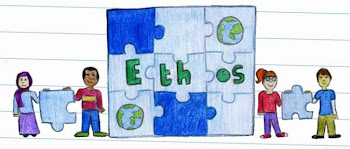Friday, October 18, 2013
White, Male, Catholic
The title of this post describes my class in school, primary through secondary: white, male and Roman Catholic.
Not much cultural diversity there. Home life was, of course, a bit more varied. We had many Protestant heretics in our street and even one Jewman in the slightly posher houses on the bank of the river. But that was it.
No black babies, except for the little head-nodding fellow on the top of the donation box, and no foreigners. None.
So my first hand knowledge of Development and Intercultural Education (DICE) is nil. Mind you, I have a slight second hand knowledge via the next generation. My son's teacher in primary school threw a freaker when the son suggested that Jesus might have looked like a native of the Middle East. NO, NO, NO, he was WHITE. And this in front of the young Indian lad sitting next to the son.
However, fortunately, times appear to have changed, and I gather that my colourful stories are now the material of history.
But there is still a way to go. Schools today are faced with problems which would have been inconceivable in my time (come in No.2, your time's up!). They have to cope with multiple immigrant nationalities, cultures and languages. Some are coping well but others are just not equipped for the onslaught, the more particularly so at a time of diminishing resources.
So Thérese (above) and Aoife (below) thought it would be a good idea to condense best practice into a set of (very loose) guidelines for schools and colleges, particularly when it came to organising intercultural events.
The booklet was launched in Dún Laoghaire-Rathdown County (I nearly said Town) Hall last evening (17/10/2013). In introducing it, Thérèse outlined the background to its production, including the research and consultation, and she stressed that ideally an intercultural event should not be an end in itself but only the tip of the iceberg of ongoing cultural integration in the schools. Everyone needed to be constantly involved, children, parents, teachers and the whole school ethos.
The aim was not integration in the sense of uniformity, but positive acceptance of difference, the avoidance of negative discrimination and racism, and everybody pulling together to educate and develop the children in the richness of diversity and mutual respect.
Her co-author, Aoife, took us through the contents of the booklet, which is beautifully produced and clearly shows the amount of thought and effort which has gone into it. It is full of interesting thoughts which would certainly not have occurred to the likes of me, and the general feeling was that the two checklists, in particular, added to its usefulness as a guide.
The Immigrant Council of Ireland has a programme called Ambassadors for Change. The idea is that some immigrants, who have made a success of their life here, are trained up to go into secondary schools to mentor students and give them positive role models.
Two such ambassadors recounted their experience at the launch. Dovile Vildaite recounted her work with Lithuanian immigrants and Waseem Yousaf emphasised his Iranian/Pakistani background and childhood in Abu Dhabi and how he was now well integrated into Irish society.
The partner organisations involved in producing the booklet were: The DICE Project; Froebel College of Education; and Dún Laoghaire-Rathdown County Council's Social Inclusion Unit.
Councillor Niamh Bhreathnach (above) formally launched the booklet and she was an ideal choice. She is a native of the county and a Froebel graduate. She has been a teacher, Minister for Education, and Lord Mayor of Dún Laoghaire-Rathdown.
She is clearly very engaged with this whole area and made some very interesting references to practice abroad. She had visited Canada where she felt that integration was weak and the different communities more or less simply did their own thing. In the USA she found that it was simply a question of the lowest common denominator.
So, no wonder she was enthused by the approach being put forward here. Drawing on her background as the grand-daughter of the last weaver in the Liberties, she said she saw society as a tapestry with each thread and weave making its own contribution to the whole and not being lost in some mushy stew. The "mushy stew" image is mine, not hers. I'm sure she had a more elegant term but I don't remember it.
I managed to get Thérèse and Niamh to pose with the booklet.
And this is some of the team. Most you know by now.
Camila Portela Byrne, a student teacher in St. Pats, Drumcondra, shows off her artwork on the booklet's back cover.
And there would be no point in a launch to an empty concourse, so you can check out some of the audience above.
One of the two very useful checklists in the booklet.
And finally, the intercultural jigsaw . This is an image which has been used by DICE before and it is both telling and subtle. You can think about it yourself.
Neither of the missing pieces will fit into the whole as presented.
Neat.
We are all in this together.
Subscribe to:
Post Comments (Atom)











Interesting. I enjoyed reading that. Sounds useful.
ReplyDeleteAny time you mention ambassadors though, it reminds me of a personal faux pas with Kader Asmal linked to when he was in Dublin (and later in government back in post-apartheid South Africa). Though come to think of it, he wasn't actually the ambassador, apart from in my imagination.
Wonderful account of an inspiring initiative. We need so much more activity of this quality.
ReplyDeleteKadar Asmal was never an ambassador. He lectured me in the IPA but.